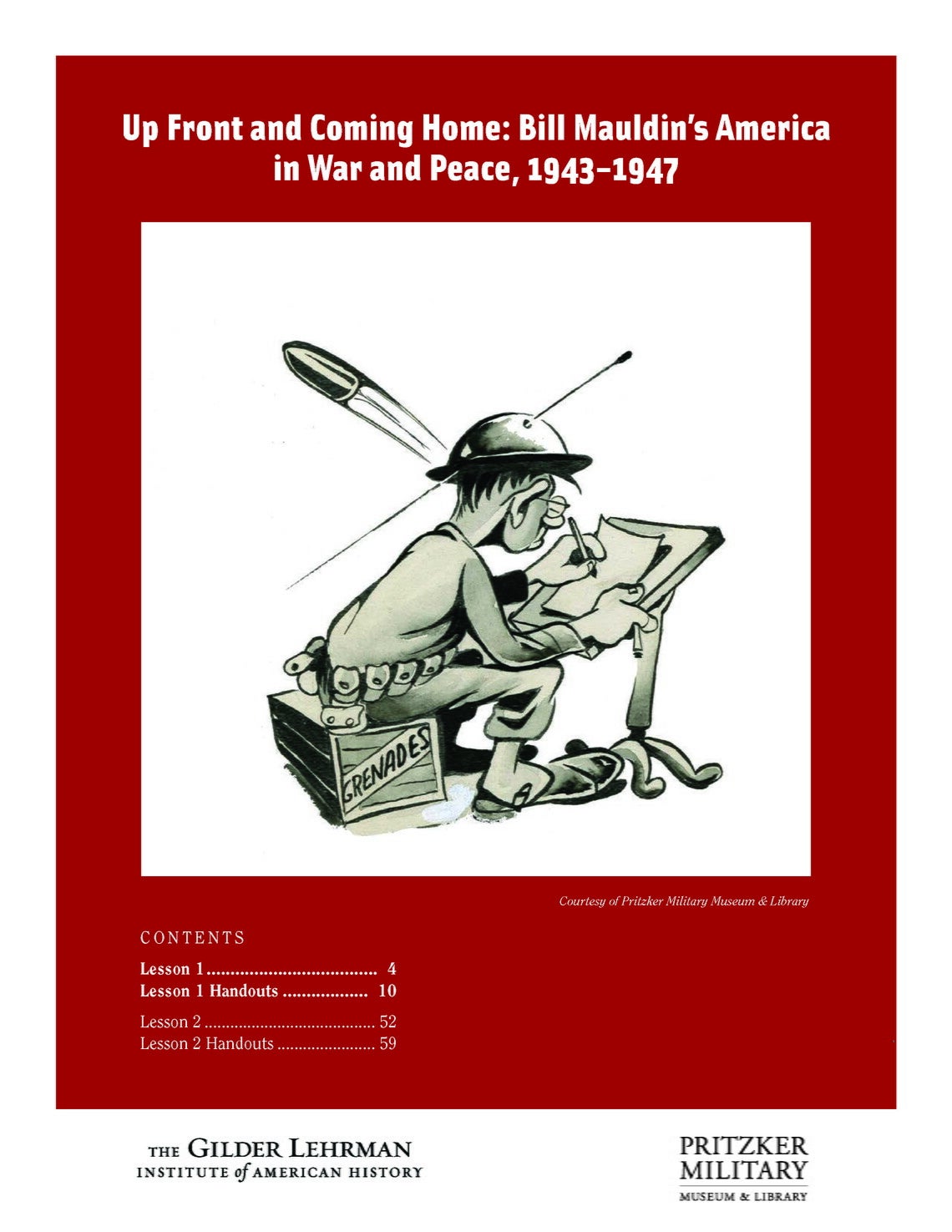Lesson by Ron Nash
Essay by Todd DePastino
Grade Level: 7–12
Number of Class Periods: 5
Primary Era: The Great Depression and World War II, 1929–1945

Students will read a secondary source by historian Todd DePastino to provide context for the life and work of Bill Mauldin or a primary source article about Bill Maulding by Ernie Pyle. They will also examine, analyze, and engage with an array of primary sources (textual and visual) that drill down into the issues raised in Dr. DePastino’s essay. The students will demonstrate their comprehension of the subject matter and their analysis and assessment of the primary sources through class discussion and completed activity sheets.
Lesson Plan Author: Ron Nash
Historical Background Essay by: Todd DePastino, author of Bill Mauldin: A Life Up Front
CCSS.ELA-Literacy.RH.6-8.1 and RH.9-10.1: Cite specific textual evidence to support analysis of primary and secondary sources.
CCSS.ELA-Literacy.RH.6-8.2: Determine the central ideas or information of a primary or secondary source; provide an accurate summary of the source distinct from prior knowledge or opinions.
CCSS.ELA-Literacy.RH.6-8.7: Integrate visual information (e.g., in charts, graphs, photographs, videos, or maps) with other information in print and digital texts.
CCSS.ELA-Literacy.RH.9-10.1: Cite specific textual evidence to support analysis of primary and secondary sources.
CCSS.ELA-Literacy.RH.9-10.2: Determine the central ideas or information of a primary or secondary source; provide an accurate summary of how key events or ideas develop over the course of the text.
CCSS.ELA-Literacy.RH.11-12.5: Analyze in detail how a complex primary source is structured, including how key sentences, paragraphs, and larger portions of the text contribute to the whole.
CCSS.ELA-Literacy.RL.11-12.1: Cite strong and thorough textual evidence to support analysis of what the text says explicitly as well as inferences drawn from the text, including determining where the text leaves matters uncertain.
CCSS.ELA-Literacy.RL.11-12.6: Analyze a case in which grasping a point of view requires distinguishing what is directly stated in a text from what is really meant (e.g., satire, sarcasm, irony, or understatement).
CCSS.ELA-Literacy.SL.11-12.1: Initiate and participate effectively in a range of collaborative discussions (one-on-one, in groups, and teacher-led) with diverse partners on topics, texts, and issues, building on others’ ideas and expressing their own clearly and persuasively.
CCSS.ELA-Literacy.W.8.1.B: Support claim(s) with logical reasoning and relevant evidence, using accurate, credible sources and demonstrating an understanding of the topic or text.
CCSS.ELA-Literacy.W.9-10.1: Write arguments to support claims in an analysis of substantive topics or texts, using valid reasoning and relevant and sufficient evidence.
CCSS.ELA-Literacy.WHST.11-12.4: Produce clear and coherent writing in which the development, organization, and style are appropriate to task, purpose, and audience.
To what extent does the sardonic humor of Bill Mauldin’s cartoons reflect and report on the challenges and hardships of American soldiers during World War II?
To what extent do the metaphors of “mud,” “men,” and “monotony” reflect and highlight Bill Mauldin’s portrayals of American soldiers during wartime?
To what extent do Bill Mauldin’s cartoons spotlight the struggles of veterans to readjust to and reintegrate into civilian society after World War II?
To what extent did Bill Mauldin’s military experience in World War II affect his personal life and career?
To what extent did Bill Mauldin’s military experience in World War II affect the creation of his postwar cartoons?
To what extent do Bill Mauldin’s postwar cartoons address the problems of racism and the abridgement of civil liberties in the United States after World War II?
To what extent do Bill Mauldin’s postwar cartoons reflect and highlight the great transformation of American society that occurred after World War II?
Ernie Pyle, “Bill Mauldin, Top Cartoonist from New Mexico,” El Paso Herald-Post, January 18, 1944
World War II Cartoons by Bill Mauldin